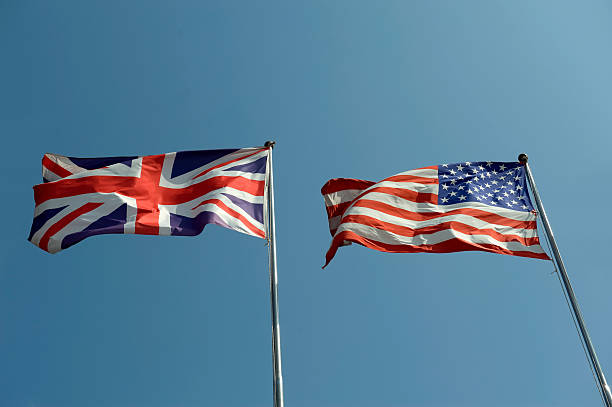The English language can sometimes be quite confusing, especially when trying to understand the differences between American and British English. While both varieties are very similar, some distinct differences in grammar, spelling, and pronunciation make these two varieties unique.
In this blog post, we will look at the differences between American and British English and explore why it is important to understand them.
Understanding the differences can help to improve communication, avoid confusion and misunderstanding, and, most importantly, foster a greater understanding of both varieties of English. Knowing the differences between the two varieties can also help you to write, speak, and understand the language more effectively.
History Of American English and British English
The history of English is a complex and fascinating one. For centuries, the two varieties of English have been in contact with and influenced each other, resulting in the two languages having very different linguistic features and cultural implications.
The history of English in the Americas begins with the arrival of the British and the establishment of the original Thirteen Colonies. During this period, people predominantly spoke the British variant of English in the colonies. This was because most of the settlers were of British origin and spoke the same language.
People referred to this language as ‘American English’ because it incorporated words from other languages such as French, Dutch, Spanish, and Native American, making it different from the British version. People Americanized the pronunciation and spelling of these words and phrases after adapting them to English. During the 18th and 19th centuries, American English evolved gradually and is still used today.
With the establishment of the United States in 1776, the country’s language became the official language, and American English became the language of government and education. This marked the beginning of the standardization of American English, which resulted in the language becoming more uniform and consistent.
The Industrial Revolution of the 19th century brought about a period of rapid development and expansion of American English. This was due to the increased contact between the American and British varieties of English and a large number of immigrants from the British Isles.
The two varieties of English have remained in contact since then and continue to influence each other. American English has become the predominant language in the United States, with British English used in certain contexts and by certain communities.
Today, American English and British English are two distinct variants of the same language, each with unique features, nuances, and cultural implications. The two varieties of English continue to influence each other and remain connected despite being used in different contexts and for different purposes.
Basic Difference
For English language enthusiasts, the differences between both languages can be fascinating. While the two languages share many commonalities, there are also subtle (and sometimes not-so-subtle) distinctions.
One of the most obvious differences is the pronunciation of certain words and phrases. In American English, people usually pronounce the ‘R’, while in British English, people often omit it. In British English, people usually pronounce “T” as “Th,” while in American English, they say it as “T.”
Another major difference is the spelling of certain words. For example, in British English, they spell “color” with an “ou,” while Americans use “o.” British people spell “theater” with a “re,” and Americans spell it with an “e.”
Another major difference is the spelling of certain words. For example, in British English, they spell “color” with an “ou,” while Americans use “o.” British people spell “theater” with a “re,” and Americans spell it with an “e.”
Besides differences in pronunciation and spelling, they also differ in terms of word choice. In American English, the word ‘dumbbell’ refers to a type of weight. While in British English, it is more likely to be referred to as a ‘weight’. Similarly, in American English, the word ‘soccer’ refers to the sport. While in British English, it is most commonly referred to as ‘football’.
Finally, both languages also have different idiomatic expressions. In British English, the phrase “to hit the sack” means “to go to the pub,” while in American English, it means “to go to bed.” Similarly, in American English, the phrase ‘to blow off steam’ means to get rid of stress. While in British English, it usually means to go for a drink.
Vocabulary Difference
One of the first things to note is the spelling of certain words. British English tends to retain the original spelling of words, even if it differs from American English – for example, the British spell “color” with a “u.” In contrast, Americans spell it “color”. Another common discrepancy is the use of the letter “s” – the British tend to use an “s” at the end of words, while Americans often replace the “s” with a “z”.
In terms of words, there are some distinct differences between the two languages. The word “favourite” has an “ou” spelling in British English, while in American English it is spelled “favorite”. Other words that have a different spelling in each variety of English include “realise” (British) and “realize” (American), “humour” (British) and “humor” (American), and “analogue” (British) and “analog” (American).
Aside from spelling, there are also some distinct differences in our words. For example, in British English, we use the term “lorry” for a truck. In American English, the term “truck” is more common. Similarly, in British English, we often use the word “crisps” for potato chips. While in American English, the term “potato chips” is more common.
Finally, there are also some differences in the way we use certain words and phrases. In British English, the phrase “on holiday” means “on vacation,” while Americans use the term “vacation.” Also, in British English, “at university” means “at college,” while Americans use the term “college.”
Difference In The Use Of Tenses
The present perfect tense is more commonly used in American English than in British English. The past perfect tense is used to express an action that has occurred in the past and continues to the present. For example, in American English, one might say, “I have been to the store,” while in British English the same sentence would be expressed using the present perfect tense, “I have been to the store.”
Another difference in the use of tenses is in the past perfect tense. In American English, the past perfect tense is used to express an action that occurred before another action in the past. For example, in American English, one might say, “I had gone to the store before I realized I needed something,”. While in British English, the same sentence would be expressed using the simple past tense, “I went to the store before I realized I needed something.”
The use of the present perfect continuous tense is also different. In American English, the present perfect continuous tense is used to express an action that has been going on for some time and is still in progress. For example, in American English, one might say, “I have been studying for the test,” In British English, the same sentence would be expressed using the present perfect simple tense, “I have studied for the test.”
Finally, the use of the future perfect tense is also different. In American English, the future perfect tense is used to express an action that will take place in the future. For example, in American English, one might say, “I will have completed my project by tomorrow.” At the same time, in British English, the same sentence would be expressed using the present perfect continuous tense, “I have been working on my project and will have completed it by tomorrow.”
Pronunciation Difference
The English language is full of nuances and subtleties that make it one of the most versatile languages in the world. People speak English in many countries with distinct accents and dialects. One of the most common differences between English dialects is American English and British English.
The distinction between American English and British English is most apparent regarding pronunciation. The main difference between American and British English lies in the pronunciation of certain vowels. In American English, the vowels tend to be longer and more open than in British English.
Another big difference is the way they pronounce the letter “r”. Americans pronounce the letter “r” as a long “er” sound. While British people usually say it as a short “uh” sound. For instance, Americans say “cahr” for “car,” while British people say “cuh.”
The differences in pronunciation between American and British English also show in some other words, such as “tomato.” Americans pronounce it “tuh-mah-toh,” while British people say “tuh-mah-toe.”
The pronunciation differences between American and British English can be difficult to spot at first, but with enough practice and familiarity with the language, they become more obvious. It is important to remember that these differences are merely a result of the different cultural backgrounds of the two countries.
Celebrate the diversity of English speakers worldwide by embracing the many accents and dialects of the English language.
Grammar Difference
Regarding grammar, there are some differences between American English and British English. Here are some of the key differences in grammar between the two dialects.
A key distinction between the two is the utilization of the current tense “have” versus the past tense “had.” People use “have” in American English to describe completed and ongoing actions. In British English, they use “had” for completed actions and “have” for ongoing actions.
Another difference between them is the use of the articles “a” and “the.” In American English, they use “the” before a singular noun and “a” before a plural noun. In British English, they use “the” before a singular noun and “a” before both singular and plural nouns.
The use of the future tense is also different. The future tense is formed using the auxiliary verb “will.” in American English, While in British English, the future tense is formed using the auxiliary verb “shall.”
In American English, people use the verb “to be” as a linking verb after a noun or adjective. British English uses it as an auxiliary verb in the same context.
Finally, the preposition “at” is different between the two languages. Americans use the preposition “at” to describe a location. British people use the preposition “at” to describe a time.
Final Thoughts
Overall, this list of differences between American English and British English has highlighted the subtle nuances between the two varieties. People widely use and understand both varieties of English despite their differences. Understanding these differences can help to ensure that communication is as clear and effective as possible.
If you want to improve your English language skills, the game-based language learning app Zoundslike is a great way to learn English in an enjoyable and interactive way. With its simple and engaging approach, Zoundslike makes language learning fun and accessible to everyone.
FAQs
Q.1 Who introduced English to other Countries?
The English language was first introduced to other countries by British explorers, traders, and colonists during the Age of Exploration and colonization in the 16th and 17th centuries. British explorers and traders brought the language to many parts of the world, including North America, India, and Australia. English has become one of the most widely spoken languages around the globe due to the influence of the British Empire.
Q.2 How do I know which version of English I should be using?
The best way to determine which version of English you should be using is to consider your audience. When writing for a global audience, you should use a widely accepted and understood form of English. When writing for a regional or national audience, you should use the most commonly used version of English in that region or country. Additionally, you should be aware of any regional variations in spelling and grammar that may be present.
Q.3 Is one version of English more widely accepted than the other?
Different regions of the world accept different varieties of English equally, but some forms such as American English and British English are more widely used and accepted.








